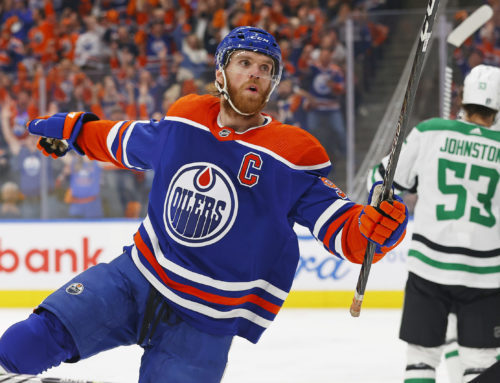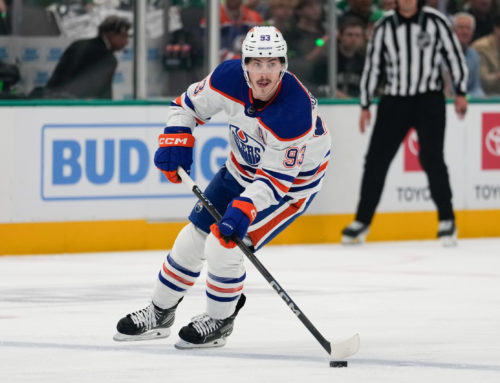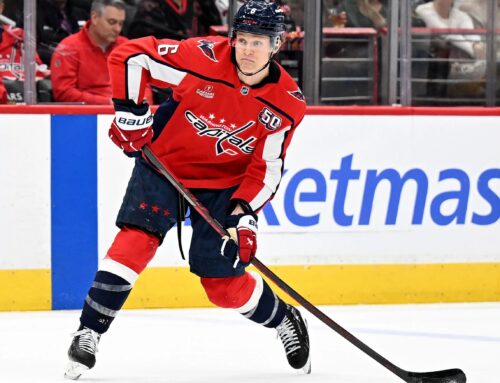The Iron-Man record has been broken. Last night Keith Yandle became the all-time leader for consecutive games played, notching his 965th in a row, having not missed a game in nearly 13 years. He is not the same player now that he once was, and he was an underrated top offensive defenceman of the early 2010s. I do wonder though how far away he is from being healthy scratched. It probably would have happened by now if he hadn't been chasing the record, and at the moment, the Flyers are missing too many guys on the back end to be scratching him now. It might not be far off though, so consider looking at replacements if he's on a deeper roster of yours for the power play upside.
*
After his three-point game last night, Nick Schmaltz is up above a 50-point pace on the season. He has been eerily consistent with his point paces over the last five seasons, sitting between 50-55 each year. With four points in his last two games, and seven in his last five, Schmaltz has been putting the puck in the net despite seeing less ice time than earlier in the season. In part, it's thanks to a hot streak by linemate Clayton Keller, who has six points in his last five games.
*
Team Canada released their Men's Olympic Hockey roster yesterday, and it's a mix of young players, ex-North American players playing overseas, plus a few players looking to make NHL comebacks sprinkled in as well.
I'm most excited to see how the young guys fare on the big stage. Owen Power could (should) be one-and-done at Michigan, and may play some games for the Sabres at the end of the year once Michigan's season is over. Jack McBain is someone I was lower on in his draft year, but he has grown into his frame, and playing against older peers in both the OJHL and then the NCAA has forced him to up his game as well. Minnesota isn't a deep team up the middle, so he may not be too far from a full-time roster spot in the NHL either.
*
The Salary Cap Skater Rankings were updated yesterday, and you can find them here. Goalie rankings should be up in time for your first coffee break at work today.
I know it may seem crazy to some that Jason Robertson and Adam Fox are ahead of Connor McDavid on the list, but the top producers that are still on rookie contracts are how you win a league. In one of my cap leagues, Jason Robertson and his six months remaining on his rookie deal were just traded for Filip Forsberg, a 2022 first round pick (15-24 range), and a prospect. It sounds like a lot to pay for Robertson, but the reality is that it may actually be a bit of a bargain for the team acquiring Robertson. I know it will never happen, but if Dallas and Nashville were to make that swap in real life tomorrow, which side would you think got the better deal? Let me know in the comments (or wherever you can find me).
*
Evan Rodrigues notched two points, breaking a scoreless streak of eight games. Hopefully you were able to sell high on him, but if not, then waiting until the end of January may be in your best interest as he has a quick chance to build some value back up. After the Arizona game last night, the Penguins' next opponents are Seattle, Detroit, and Los Angeles.
*
Could be bad news for Drake Batherson, as he was just about the only thing that Aaron Dell got in front of in the first period.
Hopefully for Batherson's sake and his fantasy owners, it's something a little more minor though.
*
If Drake Batherson misses time, then watch for Tyler Ennis, Adam Gaudette, and especially Alex Formenton to help fill out some of the depth scoring for the Senators. All three have been looking good in the last couple games, and could be worthwhile streams in the short term, as they are one of the highest volume teams over the next two weeks.
Check out the Frozentools schedule planner if you need to know what other teams to target around the all-star break, however it may be that your league is managing it.
*
Long ramble incoming:
One of my league-mates who is also a reader of the Ramblings asked me about my IPP thoughts from the other day, and how I use those to determine if a player can sustain a hot start (or vice versa). The short answer is that on its own, you can't. The IPP measurement is a great tool to have in your tool best, but it's only useful if you can look at it in conjunction with other numbers. Let me walk you through how I approach evaluating whether a player is hot, cold or just about right.
The first thing is to understand where you feel that a player should finish with regards to their production, and while you have to understand what your assumption is, you have to also be ready to be wrong. This year, we're seeing Nazem Kadri pace for 100 points, Tyler Seguin pace for less than 35 points, and Timo Meier is on pace for nearly 50 goals. I'll run through how I evaluate these players and assess what my future expectations would be for their production levels.
IPP is certainly one number I like to look at, and the best spot to find that is the Frozentools profiles. Any time I'm looking into a player, be it for an add, a drop, a trade, or a draft. Jumping to a player's profile, the initial tab is the career stats, lined up with the quarterly comparison and the lines. What I jump to first is looking at the current point pace, shot rate, shooting percentage, and ice time compared to historical seasons. I also like to look at the quarterly comparison, and see what direction players are headed. I then run through why some of these numbers might be higher or lower, and then I flip over to the advanced stats tab to see if the underlying numbers are telling the same story. Between the team shooting percentage, the IPP numbers, the shot and secondary assist rates, and more, there's lots to take in there too.
Jumping back to the players, Kadri is 50 points ahead of his top 82-game pace from any other season. Looking at Seguin, he hasn't been scoring so little since he was playing 12 minutes per game as a rookie for the Bruins. Meier is also pacing above 100 points, and has seen a huge jump in his shot rate and his ice time. Let's take this one player at a time to keep it simpler.
Kadri's scoring pace stands out because it's astronomically above anything he has done to this point, so what stands out? His 3.4 shots per game is something he has only done in one prior season, but that year he only shot 6.5%, while this year he's scoring on 12.9% of his shots (career 11.3% shooter, so this season is close enough). This season is his only other season of his career above 18 minutes per game, and it's no coincidence that the other year he did was the same year he also put up 3.4 shots per game. Kadri is also seeing a career high of four minutes per game on the power play, where he is doubling his usual scoring output. Increases in TOI, especially on the power play, with a resultant climb in shot rate (and without an inflated shooting percentage) is a great sign for sustained production.
All of those signs show that he is scoring more because he is getting more opportunities. However, the numbers still seem rather high, so let's keep going. Kadri's linemates have been rather consistent, and they aren't a huge improvement over last season either, so not much to glean from that. His second quarter output stands out as far above his first quarter or what he has done in the third quarter thus far (the past 10 games). He hasn't been scoring as prolifically in the third quarter, but his shot rate has risen above four per game, while his ice time is actually up over 20 minutes per game (still four minutes per game on the power play). No red flags here.
Strangely enough, his second quarter last year was also his best, with higher ice time, and an identical shot rate to this year. He tailed off in the fourth quarter last season, and that's something we really have to be wondering about for this year as well, depending on how the ice time and the shot rates continue to trend.
Jumping to the advanced stats, we want to see if there's any red flags that indicate there's some immediate regression coming. We already know that Kadri is way above his usual levels, and it looks like it's in part due to increased ice time, increased shot rate, and better power play deployment. With those in mind, Kadri was due for an increase in production, but how much is the question. The underlying numbers should be able to clear that up.
In the advanced stats tab, the first thing I want to do is look at his shot/60 rate, having noted his shot rate previously. The shot/60 rate shows us that his increase in shot volume per game is purely due to the increase in ice time, and that the per minute value is right in line with his career norms. His offensive zone start percentage, and his secondary assist percentage are also within his career norms.
The only real red flag is that the team shooting percentage is 13.5% with Kadri on the ice. Typically, those tend to hover at, or just above nine percent, so that will likely come down (though for an elite team like the Avalanche, maybe it doesn't come down too hard). With his team shooting at a higher percentage, Kadri is also getting in on the points at a slightly above-average rate. His IPP is 70%, a level which he hasn't posted in five years now, and 15 percentage points above his average from his first two years in Colorado. A 50-60% IPP is more along the lines of what we have come to expect from Kadri, though since he is sustainably scoring more himself, that might be why the number is a little inflated.
The bottom line on Kadri is that his third-quarter pace thus far which sees him with 52 points in 37 games might be more realistic and sustainable based on his overall and underlying numbers than his season-long pace of 115 points will be. Most people will look at Kadri as a 55- to 60-point player, and say that his pace is completely unsustainable and that you should be selling high, but he's looking and playing like a 90-point player right now. Treat him as such.
Moving on to Tyler Seguin, we know that he is just days away from his 30th birthday, and he is coming off of a major surgery and a long recovery time, robbing him of nearly the entire 2020-21 season. The initial thought on Seguin is that he's doing poorly, and he may never hit the point-per game highs again, but his talent should be enough to see him back up to at least 60, if not 70 points in a season, right? Not necessarily, try to keep an open mind in spite of what the name value might mean to you, especially so it doesn't cloud what the numbers are trying to tell you.
Looking at his Frozentools page, the career stats table has a couple things that jump out to me right away, and they're the same things I was looking at with Kadri. Seguin's 82GP pace has dropped each of the last few years, and more concerning, that matches with a decline in his shot rate and his ice time. The ice time lost is partially productive power play time as well, which really takes a bite out of Seguin's production. He's still scoring on a normal 12% of his shots this year, but even with that his production is way down.
Scrolling down to the quarterly comparison, the picture becomes even more grim. Seguin's shot rate and ice time aren't just low and declining year over year, they're even declining within the season. We also see that Seguin is not getting any exposure to Dallas's current top offensive weapons in Roope Hintz, Jason Robertson, and Joe Pavelski. When the coach is dropping your ice time and not giving you a chance with the big guns, it can take a lot to turn things around again. There is a small light though, as Seguin's third quarter scoring numbers are up, though his shot rate and ice time are still depressed. It could be a blip, or a good sign for things to come. Let's keep on it.
Before we move into the Advanced Stats tab, we have to understand that the picture painted is one of a 40-point player with a goal-heavy slant to his scoring. That's what Seguin looks like on the ice right now too, but we'll give him another chance to change our minds with his underlying numbers.
The first thing that jumps out is that his team has been shooting 5.4% with him on the ice, but the system doesn't even register that as low. That's almost half of what an average shooting team would be doing, but Seguin has been so unlucky over the last few years (and Dallas has been offensively inept on the whole) that "unlucky" is just becoming the norm. How long is it until repetitive numbers can no longer be considered an outlier? Eventually we have to consider that the shooting percentages aren't up in the average range because Seguin himself is dragging them down.
It's possible that Seguin is the cause of his own demise, or it is possible that Rick Bowness is cratering the offence around him to the point that Seguin is becoming a 40-point player under him. As long as Bowness remains coach, does it matter which it really is? Nope.
Moving through the rest of the advanced stats, Seguin's deployment has remained constant, while his shot rate shows that it is dropping per minute as well as per game (it's not just down because he's playing less minutes). There isn't even good news in his secondary assist percentage, as he's around his career average there, so he can't even bank on his production improving on the back of some cheap points.
This leaves us looking at the IPP, and trying to see if there is anything positive we can glean here. Well, Seguin's IPP and PPIPP are both at career lows, which, on its own might indicate he's due for some positive regression. IPPs on their own typically show how talented a player is, with the best players having IPPS consistently over 75%. However, going back to 2015-16, Seguin has not had a real season with an IPP of 75%. Coupled with all of the other red flags, Seguin's lack of involvement in scoring plays while he's on the ice tells us that maybe our theory above about him being the problem with his teams shooting could have some legs to it. It's tough to wrap our heads around someone falling off as quickly and drastically as Seguin has, but at this point you can't treat him as anything more than a 40-point player who may go on the occasional hot streak.
Lastly, let's look at Timo Meier. Everyone now has his five-goal performance in the front of their minds, and that game now has him on pace for a career season and nearly 50 goals. Looking at the first set of Meier's numbers, some similar things jump off the page as Kadri's profile. Meier is pacing for over 100 points, has a higher than average shooting percentage (14% compared to a career 10.5%), and his shot rate is sky high at 4.2 per game. He's doing all this in part thanks to a bump in ice time, but he's still seeing under 20 minutes per game. Meier's power play time has been a part of that ice time rise, and as a result he's already only three points away from setting a new career high for power play points.
Moving down to his quarterly comparison, it is a very good sign to see his ice time, his shot rate, and his power play opportunities increasing into the third quarter. He has moved from mainly lining up with Logan Couture to alongside Tomas Hertl, and that seems to have worked for both players of late, with Hertl on a hot-streak of six points in his last three games as well. Ice time aside though, Meier looks like someone who is putting up numbers at a level a little above where he should be right now. Let's see if the rest of the numbers line up with that.
The coloured bars on Meier's advanced stats tab give you the immediate impression that Meier is over-achieving, but it's not to the extent that the first impression makes you think. Meier's offensive zone starts, IPP, shot rate, and secondary assist rate are all within normal ranges in comparison to his career. Meier's IPP is especially noteworthy, as he's up over 80% for the second time in three years, and his PPIPP is at an elite 90% for the second year running. He's turned a corner into being an elite player. On the flip side, the team's on-ice shooting percentage is high, indicating that a few extra points may have fallen into Meier's lap. Between the team and Meier shooting slightly higher percentages, we can see that Meier is likely a few points ahead of where he should be, and with normal percentages he would have about 40 points in these 36 games instead of 46, putting him on a 90-point pace instead of 105. Meier is over-achieving, but like Kadri, he should still be an elite producer the rest of the way.
There you have it. Three players that we ran through, and you've seen what I look at and how those pieces of the puzzle come together to form an opinion on what to expect from a player. The more you look into these things and then pay attention to how the upcoming games play out, the better you will be able to understand what to look for in the future, and to draw your own conclusions from there.
Hope that helped, but in the meantime feel free to find me on Twitter @alexdmaclean if you have any follow up questions.





 EDM
EDM FLA
FLA MIN
MIN BUF
BUF CAR
CAR DET
DET TOR
TOR ANA
ANA DAL
DAL
